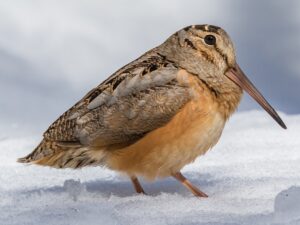
For the Birds:
Lifelong experiences with birds
By Jamie Johnston
I loved all flora and fauna as a child, I had no favorites.
I was young, a pre-teen just wanting to go out of the house to see what I could discover. I’d sneak out of the house just as the sun cast its warmth on the land in the early morning and head for the woods, snooping for hidden mammals, birds, amphibians, and insects. Finding a nest of some gamebird or songbird made my day. Coming across a fox den or tripping over a young fawn was always exciting for a 10-year old.
It was a great upbringing, in part for the differences between habitats I encountered in Cooperstown and in New Haven, Connecticut. Each was unique; New Haven more urban and gentile, Cooperstown with more working farmland. But with all the time I spent in the woods, the more I liked both. Each day was an adventure that went through constant changes thanks to weather and the seasons.
And then there was a huge change: my father took a new job 35 miles from where we lived in New Haven. Most of the lands surrounding my new home were marshes with salt air common. The sea and my new water environment replaced the forests I had once studied. In my immediate area, there were few forests other than alder, a few willow, and some spindly American Chestnut trees that never matured enough to explore.
These pockets of trees were perfect habitats for woodcock. I also found new species of ducks taking advantage of thousands of invertebrates found in the shallow tributaries of the Connecticut River or diving for small minnows hiding along the shadows of the banks.
My old elementary school in New Haven was way too far for me to attend. My new school was on the Connecticut/Rhode Island border and, for a year or two, I had no classmates to hang out with. I was often left to my own devices and became familiar with the saltmarshes. I used an old dinghy to seek out marsh wren nests — along with their “dumby” nest they construct during the nesting season — and, along the way, find an occasional duck nest or a spy a bald eagle or marsh hawk with its identifiable white patch on its tail.
My life changed again, too, in a way I hadn’t expected. My seventh-grade teacher assigned a report over vacation on a science topic of our choice. I had no luck choosing a topic until it dawned on me a lot of woodcock were going through their spring courtship as the sun went town and the moon came up. At dusk, you could often see them like leaves falling back to earth as they went through their twittering.
Without knowing much about these rotund long-beaked gamebirds, I called on the office of master birder Roger Tory Peterson. His wife Barbara kindly gave permission when I explained what I was looking for and asked if I could peruse her library for information.
Vacation came to an end and I handed in my science report. I clearly remember everything I saw; the books the field guide drawings, the pictures. I left appreciating the experience, but did not foresee this being a door to a lifetime of experience.
At least not until my doorbell rang and Barbara was there to introduce me to Tom Lovejoy. After introductions Barbara mentioned that I was young and enthusiastic and might like to work for him on his osprey research.
A new door opened!
I worked with Tom for about two years, and continued working with him on avian diseases in Brazil until he finished his Ph.D. Another Ph.D candidate from Cornell took up that mantle, and another chapter began.
[Editor’s Note: James Johnston is an avid ‘birder’ and has lived in the Cooperstown area all of his life. He earned his bachelor’s degree in wildlife management and worked as a wildlife biologist but still follows his lifelong passion for observing birds and their habitats. We look forward to featuring occasional columns on different subjects, but always all about the birds!]


What a great remembrance from The Bird Man of Cooperstown! 😎